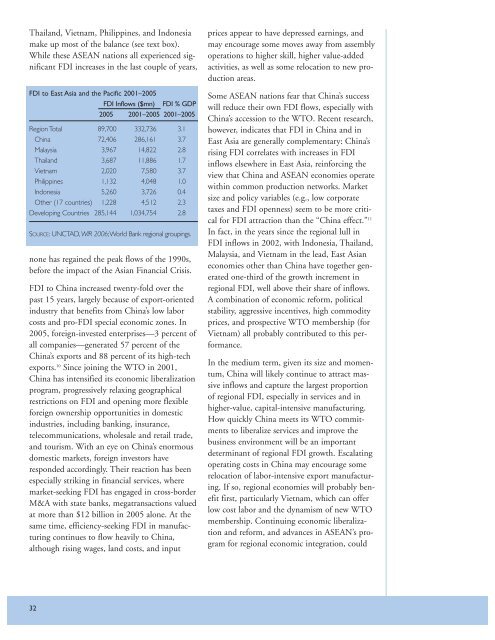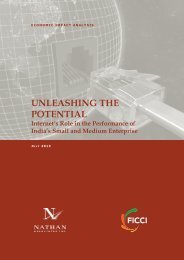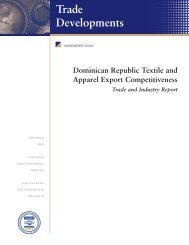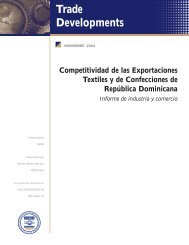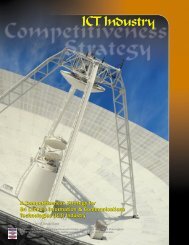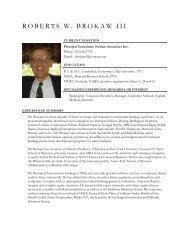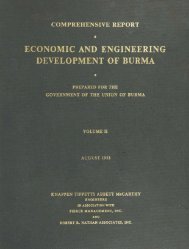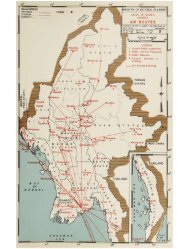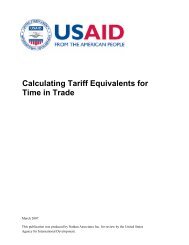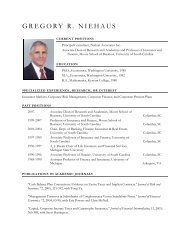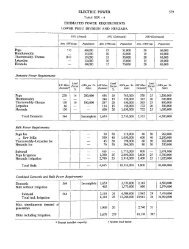Putting it to Work in Developing Countries - Nathan Associates
Putting it to Work in Developing Countries - Nathan Associates
Putting it to Work in Developing Countries - Nathan Associates
You also want an ePaper? Increase the reach of your titles
YUMPU automatically turns print PDFs into web optimized ePapers that Google loves.
Thailand, Vietnam, Philipp<strong>in</strong>es, and Indonesia<br />
make up most of the balance (see text box).<br />
While these ASEAN nations all experienced significant<br />
FDI <strong>in</strong>creases <strong>in</strong> the last couple of years,<br />
FDI <strong>to</strong> East Asia and the Pacific 2001–2005<br />
FDI Inflows ($mn) FDI % GDP<br />
2005 2001–2005 2001–2005<br />
Region Total 89,700 332,736 3.1<br />
Ch<strong>in</strong>a 72,406 286,161 3.7<br />
Malaysia 3,967 14,822 2.8<br />
Thailand 3,687 11,886 1.7<br />
Vietnam 2,020 7,580 3.7<br />
Philipp<strong>in</strong>es 1,132 4,048 1.0<br />
Indonesia 5,260 3,726 0.4<br />
Other (17 countries) 1,228 4,512 2.3<br />
Develop<strong>in</strong>g <strong>Countries</strong> 285,144 1,034,754 2.8<br />
SOURCE: UNCTAD, WIR 2006;World Bank regional group<strong>in</strong>gs.<br />
none has rega<strong>in</strong>ed the peak flows of the 1990s,<br />
before the impact of the Asian F<strong>in</strong>ancial Crisis.<br />
FDI <strong>to</strong> Ch<strong>in</strong>a <strong>in</strong>creased twenty-fold over the<br />
past 15 years, largely because of export-oriented<br />
<strong>in</strong>dustry that benef<strong>it</strong>s from Ch<strong>in</strong>a’s low labor<br />
costs and pro-FDI special economic zones. In<br />
2005, foreign-<strong>in</strong>vested enterprises—3 percent of<br />
all companies—generated 57 percent of the<br />
Ch<strong>in</strong>a’s exports and 88 percent of <strong>it</strong>s high-tech<br />
exports. 10 S<strong>in</strong>ce jo<strong>in</strong><strong>in</strong>g the WTO <strong>in</strong> 2001,<br />
Ch<strong>in</strong>a has <strong>in</strong>tensified <strong>it</strong>s economic liberalization<br />
program, progressively relax<strong>in</strong>g geographical<br />
restrictions on FDI and open<strong>in</strong>g more flexible<br />
foreign ownership opportun<strong>it</strong>ies <strong>in</strong> domestic<br />
<strong>in</strong>dustries, <strong>in</strong>clud<strong>in</strong>g bank<strong>in</strong>g, <strong>in</strong>surance,<br />
telecommunications, wholesale and retail trade,<br />
and <strong>to</strong>urism. W<strong>it</strong>h an eye on Ch<strong>in</strong>a’s enormous<br />
domestic markets, foreign <strong>in</strong>ves<strong>to</strong>rs have<br />
responded accord<strong>in</strong>gly. Their reaction has been<br />
especially strik<strong>in</strong>g <strong>in</strong> f<strong>in</strong>ancial services, where<br />
market-seek<strong>in</strong>g FDI has engaged <strong>in</strong> cross-border<br />
M&A w<strong>it</strong>h state banks, megatransactions valued<br />
at more than $12 billion <strong>in</strong> 2005 alone. At the<br />
same time, efficiency-seek<strong>in</strong>g FDI <strong>in</strong> manufactur<strong>in</strong>g<br />
cont<strong>in</strong>ues <strong>to</strong> flow heavily <strong>to</strong> Ch<strong>in</strong>a,<br />
although ris<strong>in</strong>g wages, land costs, and <strong>in</strong>put<br />
prices appear <strong>to</strong> have depressed earn<strong>in</strong>gs, and<br />
may encourage some moves away from assembly<br />
operations <strong>to</strong> higher skill, higher value-added<br />
activ<strong>it</strong>ies, as well as some relocation <strong>to</strong> new production<br />
areas.<br />
Some ASEAN nations fear that Ch<strong>in</strong>a’s success<br />
will reduce their own FDI flows, especially w<strong>it</strong>h<br />
Ch<strong>in</strong>a’s accession <strong>to</strong> the WTO. Recent research,<br />
however, <strong>in</strong>dicates that FDI <strong>in</strong> Ch<strong>in</strong>a and <strong>in</strong><br />
East Asia are generally complementary: Ch<strong>in</strong>a’s<br />
ris<strong>in</strong>g FDI correlates w<strong>it</strong>h <strong>in</strong>creases <strong>in</strong> FDI<br />
<strong>in</strong>flows elsewhere <strong>in</strong> East Asia, re<strong>in</strong>forc<strong>in</strong>g the<br />
view that Ch<strong>in</strong>a and ASEAN economies operate<br />
w<strong>it</strong>h<strong>in</strong> common production networks. Market<br />
size and policy variables (e.g., low corporate<br />
taxes and FDI openness) seem <strong>to</strong> be more cr<strong>it</strong>ical<br />
for FDI attraction than the “Ch<strong>in</strong>a effect.” 11<br />
In fact, <strong>in</strong> the years s<strong>in</strong>ce the regional lull <strong>in</strong><br />
FDI <strong>in</strong>flows <strong>in</strong> 2002, w<strong>it</strong>h Indonesia, Thailand,<br />
Malaysia, and Vietnam <strong>in</strong> the lead, East Asian<br />
economies other than Ch<strong>in</strong>a have <strong>to</strong>gether generated<br />
one-third of the growth <strong>in</strong>crement <strong>in</strong><br />
regional FDI, well above their share of <strong>in</strong>flows.<br />
A comb<strong>in</strong>ation of economic reform, pol<strong>it</strong>ical<br />
stabil<strong>it</strong>y, aggressive <strong>in</strong>centives, high commod<strong>it</strong>y<br />
prices, and prospective WTO membership (for<br />
Vietnam) all probably contributed <strong>to</strong> this performance.<br />
In the medium term, given <strong>it</strong>s size and momentum,<br />
Ch<strong>in</strong>a will likely cont<strong>in</strong>ue <strong>to</strong> attract massive<br />
<strong>in</strong>flows and capture the largest proportion<br />
of regional FDI, especially <strong>in</strong> services and <strong>in</strong><br />
higher-value, cap<strong>it</strong>al-<strong>in</strong>tensive manufactur<strong>in</strong>g.<br />
How quickly Ch<strong>in</strong>a meets <strong>it</strong>s WTO comm<strong>it</strong>ments<br />
<strong>to</strong> liberalize services and improve the<br />
bus<strong>in</strong>ess environment will be an important<br />
determ<strong>in</strong>ant of regional FDI growth. Escalat<strong>in</strong>g<br />
operat<strong>in</strong>g costs <strong>in</strong> Ch<strong>in</strong>a may encourage some<br />
relocation of labor-<strong>in</strong>tensive export manufactur<strong>in</strong>g.<br />
If so, regional economies will probably benef<strong>it</strong><br />
first, particularly Vietnam, which can offer<br />
low cost labor and the dynamism of new WTO<br />
membership. Cont<strong>in</strong>u<strong>in</strong>g economic liberalization<br />
and reform, and advances <strong>in</strong> ASEAN’s program<br />
for regional economic <strong>in</strong>tegration, could<br />
32


